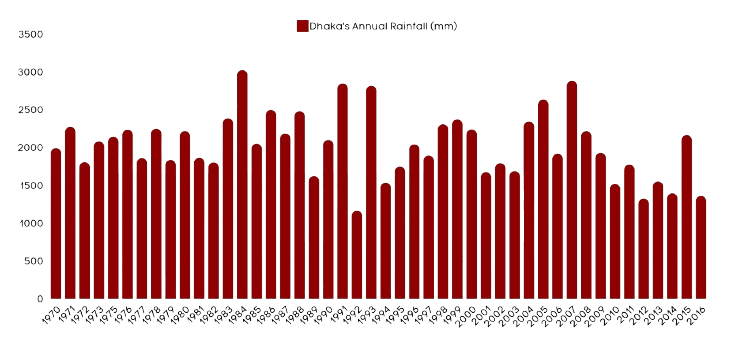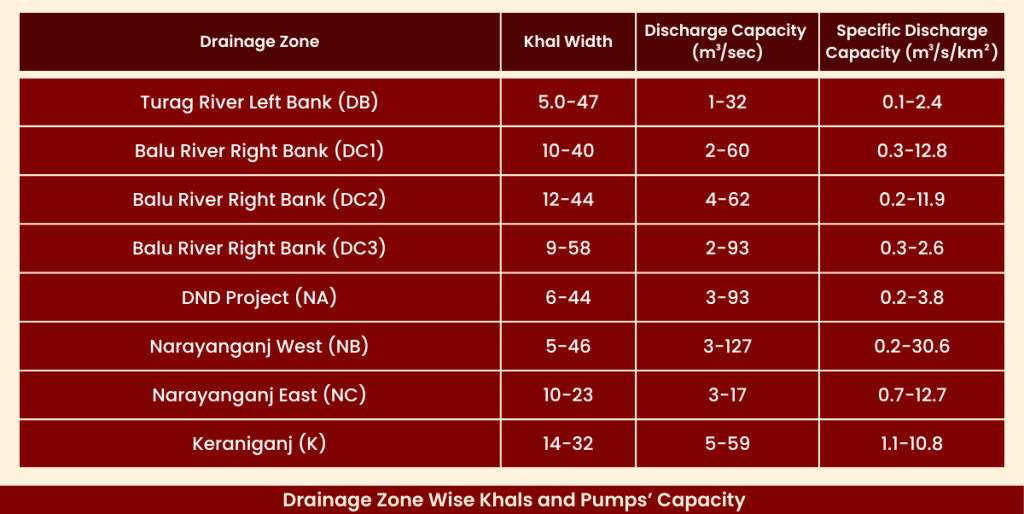The Dhaka city faces escalating challenges with each passing monsoon, the city becomes increasingly susceptible to the unbearable impacts of waterlogging, which wreaks havoc across urban life. Insensitive urbanization, driven largely by private land development and, to some extent, the real estate industry, has exacerbated the issue by neglecting the establishment of adequate drainage and sewage infrastructure. Additionally, natural drainage systems are increasingly obstructed by expanding impervious surfaces, worsening the situation.
0
mm
Average Annual Rainfall in Dhaka
Dhaka has tropical wet and dry climate under Köppen climate classification. Monsoon brings quite heavy rainfall in Dhaka, but it is quite normal that every month of the calendar may have at least 7-10mm while it can go beyond 370 mm in July. From the years 1970 to 2016, Dhaka had an average annual rainfall of 2042.63 mm.

0
mm
Expected Rainfall in May-September
This year, in 2024, according to the Meteorological Department of Bangladesh, Dhaka is expecting heavy rainfall in May, June, July, August and September, each of the month having more than 300mm rainfall.
Average Monthly Rainfall
- January7.7 mm
- February28.9 mm
- March65.8 mm
- April156.3 mm
- May339.5 mm
- June340.3 mm
- July373.1 mm
- August316.5 mm
- September300.4 mm
- October172.3 mm
- November34.4 mm
- December12.8 mm
Rainwater runoff is directed toward the rivers surrounding Dhaka. Throughout the monsoon season, many distributaries of the Buriganga river remain elevated, leading to a backwater effect in the interconnected drainage system comprising storm sewers and channels. This results in sluggish flow velocities for several days as flood-water drains through the rivers. Fortunately, Dhaka’s lakes and low-lying areas serve as significant retention reservoirs, mitigating the risk of flooding during intense storms. However, these water retention bodies are increasingly threatened by human activities, contributing to waterlogging issues.
Bottlenecks
Poor Discharge Capacity of Drainage Pipes
The drainage system in Dhaka suffers from poor discharge capacity, exacerbating water logging issues in the city. Despite efforts to establish spatial relationships with the existing natural drainage network using drainage buffer distances, the drainage infrastructure’s limited capacity is evident. This is highlighted by the proximity of built-up areas to streams, with closer proximity indicating a lower risk of waterlogging due to quicker runoff.

However, during the monsoon season, inadequately treated drainage becomes a major contributor to waterlogging, compounded by the fact that half of the city’s drains are uncovered and frequently clogged with garbage. Despite efforts by organizations like WASA to provide 38% of the city’s drainage and sewerage network, the storm sewer network remains insufficient to handle the increasing urbanization and population growth.
As built-up areas continue to expand due to rapid urbanization, especially in the middle and northern parts of the city, the drainage network struggles to keep pace, leaving these areas highly vulnerable to waterlogging. Moreover, the extent of calamities associated with waterlogging is closely linked to population density, with areas of high population density experiencing higher vulnerability.
Half of the City’s Drainage are not Covered
The lack of coverage on half of Dhaka’s drainage lines poses a significant challenge to the city’s efforts to manage water flow effectively. Without proper covers, these drainage lines are vulnerable to the ingress of various solid and unwanted wastes. This includes debris, food, plastics, packaging of daily goods, metal, rubber, concrete and other materials that can easily obstruct the flow of water within the drainage system. Additionally, the absence of covers makes it easier for people to directly dispose of solid waste into the drainage lines. This irresponsible behavior exacerbates the problem, as it introduces even more waste into the system, further impeding the flow of water and increasing the likelihood of blockages and waterlogging.
Natural Drainage Channels are Encroached upon
0
Natural Drainage Channels/Khals
Dhaka’s natural drainage system mostly relies on water retention channels which extends to Dhaka’s adjacent rivers. These channels (referred as ‘khal’) discharge rainfall-runoff. There are about 45 natural canals or khals inside Dhaka city’s border. And as of capacity, natural canals are capable of draining 80% water of Dhaka.

But due to building encroaching upon canals impeding water flow makes the natural drainage system lose its capacity resulting in water logging. More pathetic is that around 10 canals have been filled entirely or turned into box culverts to construct roads. The Rayerbazar, Rajabazar, Gopibagh and Shyampur Kadamtala canals have been filled up to build roads. And Segunbagicha canal, Dholai Khal-1, Dholai Khal-2, Debdholai Khal and Paribagh canal have been narrowed down for building box culverts.
Insufficient Collection of Solid Waste
Insufficient collection of solid waste contributes significantly to waterlogging in Dhaka city. Without proper waste management practices in place, solid waste accumulates in the streets and public areas, eventually finding its way into the drainage system. This waste includes debris, plastics, and other materials that obstruct the flow of water within the drainage channels. Additionally, the direct disposal of solid waste onto the streets and into open areas further exacerbates the problem by clogging drainage channels and impeding water flow. To address waterlogging effectively, it is crucial to improve solid waste collection and management practices, ensuring that waste is disposed of properly and does not obstruct the city’s drainage infrastructure.
Inadequate Length of Drainage Pipes
Drainage pipes of Dhaka are mainly constructed in two kinds, brick pipe and concrete pipes. Concrete pipes are mostly narrow but longer in length covering more area. Due to high buffer zones, length of drainage pipes falls short in proportion with population density of Dhaka resulting in over-capacity flow. Thus the entire system breaks apart. The below figure shows the vulnerability in relation to population density of Dhaka.

Slums and Poor Housing Conditions
City dwellers living in informal settlements include slums and poor housing (regarded as jhupri and kaccha) residents. This population can be considered the most vulnerable community in the city. These communities often do not have proper sanitation and sewage systems. Their unplanned sanitation system leads to water logging becoming more severe in those areas.


Remedial Initiatives
Dhaka Water Supply and Sewerage Authority was established in 1963 and it is the authority responsible for drainage systems. Masterplan for Dhaka’s drainage and sewerage was first prepared in 1968 and later revised in 1991. The WAPDA was appointed to construct flood embankment and pumping stations. DPHE was appointed to construct internal drainage system
Dhaka has been divided into three regions in terms of drainage basin by DWASA in 2012.
Dhaka-Narayanganj-Demra (DND) Region
This region consists of a 60 sq km area which was included in Bangladesh Water Development Board’s irrigation project. DND region has Demra Pumping station which works as both storm water drainage and irrigation facility for the project. This pumping station was constructed in 1968. Total design discharge capacity is 14.52 cubic meters/second (Jica’s Supporting Report H, Storm Water Drainage). This area is flood protected by polders.
Western Dhaka Region
This region extends from Tongi Khal(North) to DND area(South) and Pragari Sarani-Atish Dipankar Road(East) to Turag-Buriganga River(West). This region includes 142 sq km area and it is flood protected. There are catchments that include the sewerage system which drains industrial waste water and household discharges. However, DWASA in 2012 addresses that existing sewerage system is NOT properly functional.
Eastern Dhaka Region
This region consists of 116 sq km area which extends from Atish Dipankar Road-Pragati Sarani to Balu river as east to west. And from Tongi Khal to the DND area as north to south. Most of this region is NOT protected from flood. However, domestic and industrial discharges typically poured to Gulshan, Banani and Hatirjheel lakes. This area was overtaken by residential development which was previously reserved as flood plain.

Khals and Pumping Stations
The drainage capacity of existing canals or khals has become poor with time. The required specific discharge capacity is more than 8 cubic meters/ second/ square kilometers. But most of the canals average at less than 8 cubic meters/ second/ square kilometers. Widening these canals and restoring them needs immediate consideration.
There are three dedicated storm-water pump stations operational in Western Dhaka. Goranchanbari, Kallyanpur and Dholai khal are the three areas that are connected to storm-water retention ponds. A new pump in Kamalapur was inaugurated in 2016. And the Government planned to install two more stations in the Eastern Dhaka region.
Narinda Pumping station is located in old Dhaka and covers an area of 4.23 sq km. Total design drainage capacity of this pump is 9.6 cubic meters/second. It is equipped with four pumps, one reservoir tank, one gravity channel, one emergency channel and three gates. This pump was established in 1975 by the DPHE and this pump is capable of draining almost the entire old Dhaka’s area.

Government is implementing the construction of a new pumping station with an overall capacity of 22.2 cubic meter/ second at the opening of Dholai khal. With financial assistance from the World Bank, this project includes the renovation work of Dholai khal as well. This project is set to replace the decades old Narinda pumping station.
What went wrong with Pumping Stations?
The existing pump stations in Dhaka fail to provide satisfactory drainage due to multiple reasons.
- The decades-old pumping station faces suction water level much higher than originally designed in order to support a required hydraulic gradient of the drainage pipes. This hampers smooth collection of storm water to the pump station.
- The continuous operating hours of some of the pumps are limited to several hours due to overheating. For example, the Narinda pumping station operates from late May through early December every year. The operating hours are estimated to be around 1000-1500 hours per pump. Considering the capacity of the pumps, this is insufficient for the overflow.
- Hydraulic head loss of 0.3-0.6 m is caused every time due to blockades created by solid trash at the screens. This heavily affects the efficiency of the pumps. As of now, these are removed by manual screening.
- Sometimes, the pump stations are not operated due to the stoppage of power supply. For instance, the DND irrigation pump averages at 1200 hours while it has a capacity of operating up to 1980 hours.
Recommendations
-
- Replacement of old and inefficient pumps: Upgrading the outdated and inefficient pumps in Dhaka’s drainage system is essential to enhance its performance and alleviate water logging issues. By replacing these aging pumps with modern, more efficient ones, the city can improve its capacity to handle excess rainfall and mitigate the risk of flooding.
- Machinery backed trash collection at pumps: Manual labor is currently being the only input in terms of trash screening and collection. By replacing manual labor with automated screening systems, the process becomes more efficient and less labor-intensive.
- Separate power line or installation of generators at pumps: Installing separate power lines or generators at pump stations is crucial to ensure uninterrupted operation during power outages, enhancing the reliability and effectiveness of the drainage system in Dhaka.
- Covering drain lines: Covering drain lines is essential to prevent the accumulation of solid waste and debris, reducing the risk of blockages and waterlogging. This measure also enhances safety by minimizing the risk of accidents and improves the overall aesthetics of the city’s drainage infrastructure.
- Widening up natural canals: Widening natural canals and restoring them to their original state is crucial for improving water flow and reducing waterlogging in Dhaka. This initiative enhances the capacity of the drainage system to handle excess rainfall and mitigates the risk of flooding in the city.
Cover Photo: The Business Standard
About the Author

Hamim Mubtasim is the Brand Manager at The Confluence. He is currently pursuing his undergraduate studies at the Institute of Business Administration, University of Dhaka. A business student by choice and marketing geek by passion, he aspires to manage big brands someday.